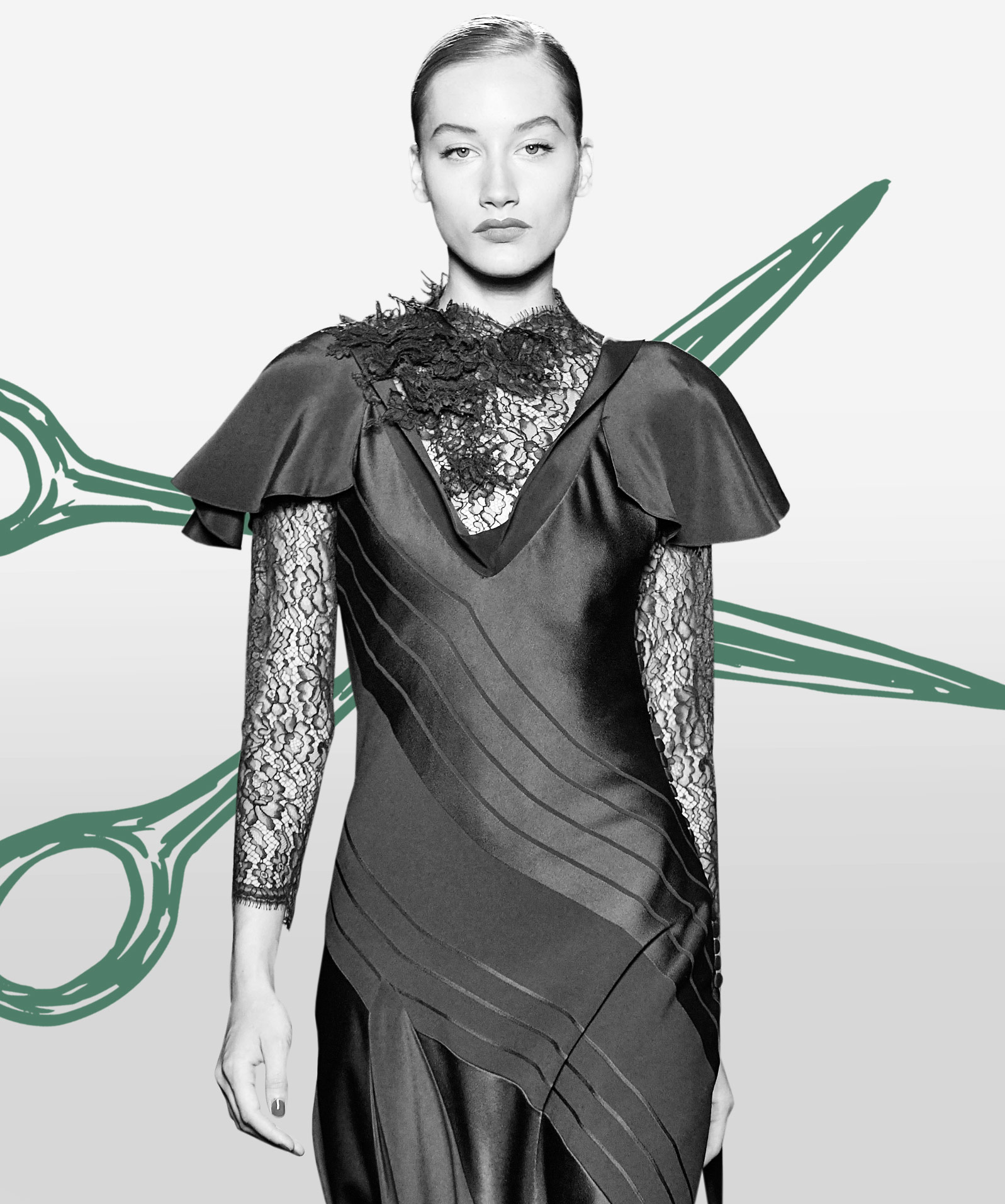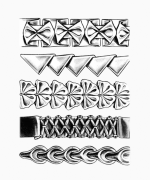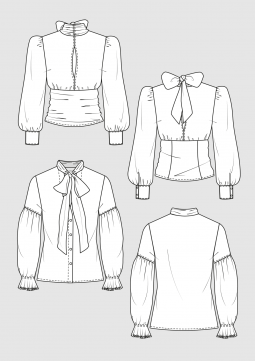Tips for Cutting Fabric
Deutsch
 (Photo Credit: © CATWALKPIX.COM)
(Photo Credit: © CATWALKPIX.COM)
After making the pattern and choosing the suitable fabric, all parts of the pattern should be transferred onto the fabric and then be cut out. In order to avoid any unpleasant surprises during this step and to make a well-fitting garment out of the valuable fabric, we explain here how to cut the fabric and what you should pay attention to.
Content
- What do you need to cut the fabric?
- How do you find the grain?
- Placing and fixing the pattern
- Cutting the fabric correctly
- How can I tell which is the left side of the fabric?
- Cutting in bias cut
What do you need to cut the fabric?
- For cutting the pattern pieces out of the fabric you absolutely need sharp fabric scissors. Fabric scissors and rotary cutters should be sharp, as the exact cutting of the pattern pieces is essential for the later fit of the garment. A pair of fabric scissors used to cut the pattern paper quickly becomes blunt and causes errors when cutting the fabric.
- To fix the cut pieces of paper to the fabric, aids such as pins, fabric clamps and fabric weights are used.
- To draw the pattern on the fabric, use a simple tailor’s chalk in a contrasting colour. So use a white chalk for dark fabrics and for light fabrics a darker chalk. Alternatively you can also use a trick marker or marker pen.
How do you find the grain?
Before the fabric is aligned for cutting, the fabric should be washed. This prevents the sewn garment from shrinking or warping later.
In order to place the pattern pieces correctly on the fabric, the grain of the fabric must be observed. In our clothing the grain runs mostly vertically from head to toe. It is also possible to cut a fabric crossways or even diagonally to the grain. More about this later. So it is important to locate the grain of your fabric. There are a few simple ways to find the grain:
- The grain always runs parallel to the selvedge. Most fabrics have a selvedge on the right and left side of the fabric. You can recognize them by the fact that the fabric is often not printed on the edge, has small holes from the weaving machine or is fraying a little.
- In the direction of the grain, fabrics are usually firmer and less or not stretchable. So you can also find the grain with the help of a stretch test.
- If the selvedge is not visible and the stretch test is unclear, a single thread can be pulled out of the fabric to find the grain. Whether the thread you pulled out was a weft thread (threads running crosswise in the fabric) or a warp thread (threads that are stretched lengthwise in a loom during the production of the fabric), you can find out in a tear test. A fabric is always tearable in the direction of the warp threads. The grain lies parallel to the warp threads.
- The print of a fabric can be another indication of the grain. If the fabric print is printed in one direction, it can be assumed that the grain runs in the same direction as the print.
- With velvet, cord and microfibre (fleece), the grain can also be recognised by the line direction. If you stroke against the line direction, the hairs (pile) will stand up. The thread runs in this direction, as well.
- With elastic fabrics, such as fine rib or jersey, it is particularly important to pay attention to the direction of stretch and the grain. In comparison to woven fabrics, knitted fabrics are more stretchable in both directions. Therefore, the stretch test here is different. With knitwear, the grain is easy to see. If the fabric is pulled apart a little, “stripes” become visible. These stripes indicate the direction of the grain.
Now you have located the grain of your fabric and can align the paper pieces with the grain sign on the pattern. Attention: never forget to mark the grain when making pattern templates!
Placing and fixing the pattern
All pattern pieces now are placed on the fabric as space-savingly as possible and aligned with the grain. They are fixed with a few needles and weights to avoid slipping.Before the pieces can be drawn and cut with tailor’s chalk, the seam allowances have to be marked with a small hand measure. However, there are also finished sewing patterns where the seam allowance is already included.
Cutting the fabric correctly
There are several ways to cut the fabric:
- Often a pattern, e.g. for a top, shows only half of the front and back part up to the front and back centre. Here, the pattern is then placed against the folded edge (fold) of the double-layered fabric and cut. To cut in the fold, the fabric must be folded in the middle, parallel to the grain and left on left side of the fabric and the pattern piece must be placed exactly on the folded edge.
- There is also the possibility to cut pattern pieces to the mirrored. The fabric is then folded again, left to left. You cut out two pieces in one step. You do this with pieces of which you need two, like the sleeve or a trouser leg.
- If a pattern piece is only needed once, it can also be placed on an unfolded fabric (left side of the fabric is on top) and cut.

Attention: Most fabrics have a line direction, which means that the fibres have been combed in one direction by weaving processes and a specific finish. If individual pattern pieces are cut in different directions and against the line, colour differences, different shine (sometimes only visible under certain lighting conditions) and in extreme cases even a different handle can occur. Therefore, when placing the pieces, make sure that all pieces are placed in the same direction and against the grain. Nevertheless, there are materials that allow some parts to be laid down in a tilted position, this is often associated with a significant reduction in fabric consumption, even the clothing industry, where every cent is at stake, often differentiates sensitively with a high expenditure of prior fabric tests. Under sleeves, back trousers orInside facings can be cut the other way around.
How can I tell which is the left side of the fabric?
The right fabric side is the “nice” side. Here you can see the pile or a print. The left side of the fabric is always the inside of the later garment. It is often white on printed fabrics and sometimes has a rougher surface. It is later the outside of the garment.
Cutting in bias cut
The diagonal cut or bias cut is a cutting technique in which the fabric is cut at a 45° angle to the grain. Fabrics are more elastic in the diagonal, so the finished dress is more supple in the bias cut and the fabric has a softer fall than in the normal cut, where the fabric is cut parallel to the grain. The Parisian fashion designer, Madeleine Vionnet, is considered the inventor of the bias cut.

What to consider when cutting and sewing:
- In order to obtain a reliable reference point for the grain, it is recommended to first pull a single yarn out of the fabric.
- With this line as orientation you can then mark squares of 10 centimeters side length with row yarn, this makes the alignment of the pattern pieces much easier and you can see immediately when the fabric has moved out of the diagonal. Errors that occur during cutting because the thread is not exactly diagonal can hardly be corrected later, even with a lot of tailor know-how. Tiny hems, wandering seams, twisted parts can be the unpleasant result.
- It is essential that the pattern pieces are laid out completely and cut in one layer. In order to prevent the finished garment from twisting around the body, the diagonal grain line should run in the opposite direction on the front and back pieces.
- To keep the fabric as still as possible when cutting, you can put a velvet or wool cloth underneath.
- With bias cut, the fabric has a certain elasticity due to its position, which means that it can expand. If the seams do not follow this, problems can occur.
- Instead of conventional seams, a very small zigzag stitch is therefore recommended for bias cut.
Cutting instructions and patterns for sewing can be found in our online shop



